Business Overview and the Sources of Craftsmanship
Sumitomo Mitsui Construction Business and Portfolio
Highly attuned to the needs of a diverse and ever-changing market, our Group applies its technologies and expertise acquired through years in both the civil engineering and building construction businesses, expanding its businesses around the world with the mission of bolstering regional infrastructure that supports local communities.
The project site is core to our construction business. It is there that we plant and nurture the seeds of various business developments, without compromise on safety or quality, and while completing construction on schedule. One example of this is improving productivity through a move to digitalization. Technological development that enhances our competitiveness is not only carried out in research labs but also on project sites, paving the way for the development of new markets that are expected in the future. With project sites as our core, our business is supported by four segments: our domestic civil engineering business, where we will continue focusing on leading technologies such as the construction of PC bridges; our overseas business, which is benefiting from the recovery from the COVID-19 pandemic; our domestic building construction business, where we will continue focusing on improvements in performance, and lastly, our new business & construction peripheral business which is expanding our renewable energy business, to contribute to a decarbonized society.
The source of strength in these businesses lies fundamentally in the technology underpinning craftsmanship and the human resources who pass this on, and in order to respond to changing market needs, we are further honing the technology we have cultivated by leveraging our internal and external networks.
We will continue to develop a business that can grow sustainably, so that we can provide value suited to the new needs of society through craftsmanship, while responding to the trust of our stakeholders, and aiming toward achieving the Vision 2030.
The Market Environment and Addressing Challenges by Utilizing Technologies
Utilizing Technology in Civil Engineering
▶ Recognition of the Market Environment
Updating and repairing highways has become an urgent issue for social infrastructure. Constraints on areas and periods in which construction is possible make this renewal work more difficult. Our company has performed large-scale deck slab replacement renewal work on major highways across Japan such as the Tomei Expressway, the Meishin Expressway, and the Chugoku Expressway. We need to leverage our experience and track record in this in order to carry out this construction work more safely and efficiently.
▶ Examples of Using Our Technology
Robotaras®Ⅱ
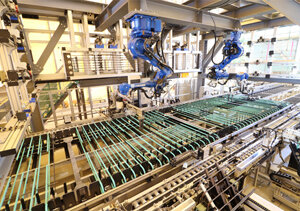
We are utilizing Robotaras®Ⅱ automated rebar assembly system in actual operations. By automating work for about 85% of the total weight of rebars, we have achieved a threefold improvement in productivity. The system automatically stops the equipment if a person or object enters the safety fence during operation.
SMC-Slab
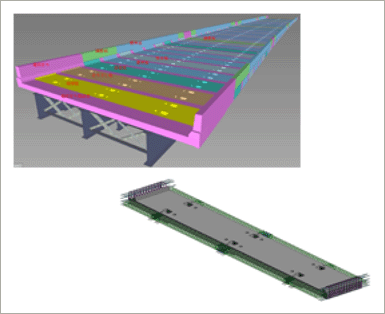
Importing information entered into a general-purpose spreadsheet software into CAD software makes it possible to create structural dimension drawings automatically. This has reduced the time for drawing revisions, fine-tuning, and repetitive review tasks to one-third of previously.
Utilizing Technology in Building Construction
▶ Recognition of the Market Environment
While domestic construction orders for the Japan Federation of Construction Contractors remained strong in fiscal 2023, there were increased supply-side risks and constraints including rising prices for construction materials, a decline in skilled workers, and soaring labor costs. From April 2024, appropriate construction schedules in response to overtime work limits are expected to prolong the construction periods. This requires a high-productivity construction system that does not rely solely on on-site work.
▶ Examples of Using Our Technology
SQRIM method / SQRIM-H method
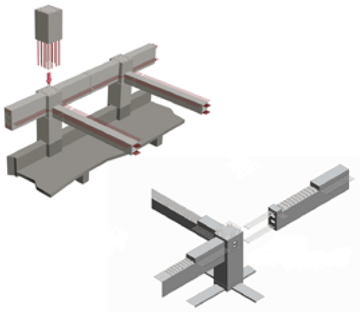
This method, in which the structural frame is made of precast concrete (PCa) fabricated at a factory and assembled on-site is less susceptible to the effects of weather and surrounding environments, and is suitable for high-quality management. Precasting all column and beam components and minimizing the amount of concrete poured on-site allows for both high quality and improved construction speeds.
DOC method / Hi-DOC method
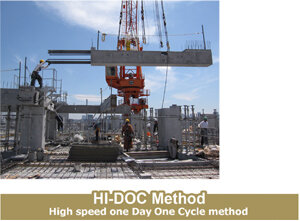
The Hi-DOC method, a system construction method, achieves short construction periods and mass production when combined with the SQRIM method. Dividing the construction floor into multiple zones and completing the same process in each zone in one day means construction can be completed in a 3-day cycle per floor.
Utilizing Decarbonization Technology
▶ Recognition of the Market Environment
With the aim of achieving a decarbonized society, we need to consider not only the materials and fuels used in construction, but also how we can reduce the energy used during the building's operational phase. Effective materials that contribute to decarbonization include low-carbon concrete and wood, which stores carbon.
We are actively introducing energy-saving and energygenerating technologies in buildings to promote ZEB/ZEH, and are working on floating solar power generation utilizing existing water surfaces. The potential for power generation in domestic reservoirs is high, in particular for agricultural ponds, where we expect to see effects such as preventing water temperature increases, preventing evaporation, and suppressing algae. Additionally, after installation, constant remote monitoring using surveillance cameras and the installation of water level gauges and anemometers also contribute to enhancing resilience during disasters.
For energy-generating technologies other than solar power, we are focusing on biogas power generation from chicken manure, which is produced at a rate of approximately 13 million tons per year in Japan, and we are working toward the first domestic practical application of this technology.
▶ Examples of Using Our Technology
Wooden structure roof truss
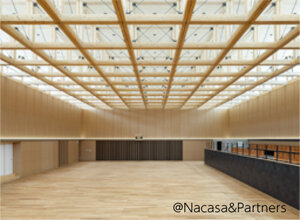
We actively promote decarbonization by utilizing wood, a store of carbon. The structure supporting the roof of the building adopts a large-span framework made of domestic timber, with a wooden lattice structure. This design evokes the delicacy and warmth of the traditional Japanese kumiko latticework.
Single-occupancy ZEH apartments
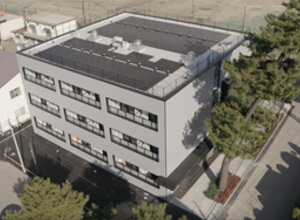
Our Shikoku branch's Taishi Dormitory is an environmentally conscious dormitory facility, achieving the first Net-Zero-Energy House Mansion (ZEH-M) in the general contractor industry. This reduces running costs through efficient energy storage and heat retention, and is expected to recoup costs over 15 years of actual use.
Offshore floating solar power generation
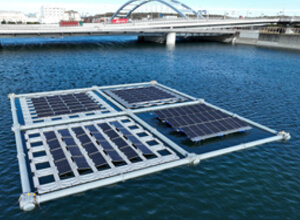
facility (Tokyo)
We have developed our own floating solar power generation system, and are currently developing a new system that can be used on the ocean and in deep dam lakes. This technology has been selected by the Tokyo Metropolitan Government for the 2022 Tokyo Bay eSG Project's pilot, and we are participating in the demonstration project. Currently, design and construction of the floating and mooring system has been completed, and in April 2024 we started various measurements and demonstrations.
Chicken manure biogas technology
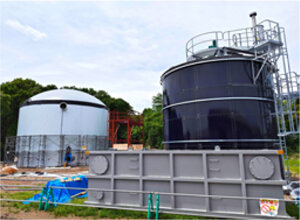
demonstration plant (Tochigi Prefecture)
We have been selected by the Ministry of the Environment's "Regional Co-Creation and Sectoral Cross-Sectional Carbon Neutral Technology Development and Demonstration" project, and are continuing to construct a demonstration plant with a partner poultry business based around the theme of "developing an energy recovery technology using egg-laying chicken manure as the sole raw material," with the objective of establishing the technology by fiscal 2025.
The Source of Our Craftsmanship / Proprietary Technologies Supporting Our Strengths
Changes in the Number of Our Proprietary Patents
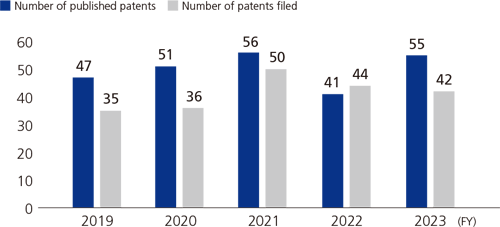
We participate in urban development through civil engineering structures such as bridges, roads and tunnels that support people's daily lives, and structures such as buildings, condominiums and commercial facilities that support affluent lifestyles. Since our founding, we have maintained the spirit of boldly taking on the challenge of creating unprecedented products. We will continue to challenge "Japan's first" and "world's first" technologies and work to provide "new value" in the future.
▶ Our Key Proprietary Technologies
The following areas can be swiped left or right to scroll horizontally.
| Civil Engineering | Large scale renewal (deck slab replacement) |
|
| Productivity improvement on construction sites |
|
|
| Longer life and greater durability | ||
| Building Construction |
Achieving a decarbonized society (energy saving technology) |
|
| Earthquake disaster prevention technology |
|
|
| Common to Civil Engineering and Building Construction |
Achieving a decarbonized society (Scope 3 emissions reduction) |
|
| Productivity improvement on construction sites |
|
|
| New Business & Construction Peripheral |
Use of renewable energy |
|
▶ Recent Technological Developments to Meet Client Expectations and Solve Social Problems
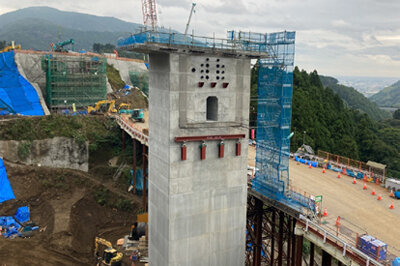
Column Head SPER Construction Method
Hollow shape PCa parts of the same size as the piers (substructure) are placed on top of the piers, and concrete is poured to construct the column heads after the rebar and PC are assembled. This eliminates the need for large brackets as in the conventional method. The use of PCa parts with embedded rebar reduces the amount of bar arrangement and formwork required on site, thereby reducing labor and risks from working at height, providing improved productivity and safety.
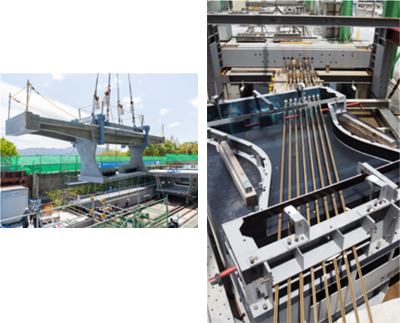
Dura-Bridge®
Developed to make bridge structures maintenance-free, the ultra-durable bridge (Dura-Bridge®) uses aramid FRP rods, a non-corrosive material, instead of rebar and PC steel to achieve durability far superior to that of conventional PC bridges. In 2020, it was used for the first time as a mainline highway bridge for the Bessodani Bridge on the Tokushima Expressway. The lifecycle CO2 emissions can be reduced by 55% compared to conventional concrete bridges, and is expected to be applied as one of the decarbonization technologies in the future. The high durability of renewal floor slabs (Dura-Slab®) and wall balustrade (Dura-Barrier®) has also been applied to actual structures and is expected to become more widespread.
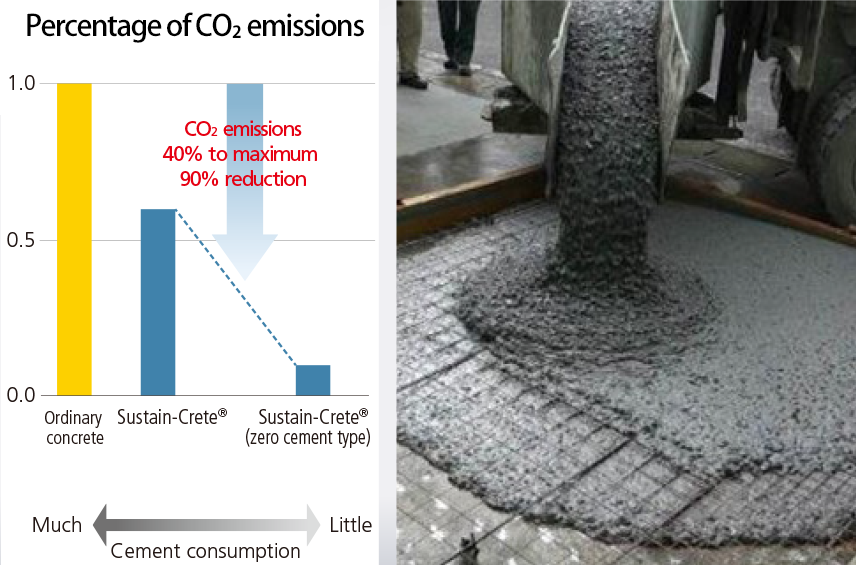
Sustain-Crete®
We have developed and are promoting the use of Sustain-Crete®, an environmentally friendly concrete that reduces CO2 emissions by 40% to a maximum of 90%. It has already been applied to the Sustain-Joint method, a method of joining precast PC deck slabs, and the Sustain-WALL Zero® non-structural material. We will continue to develop further applications and promote the use of Sustain-Crete® for PCa parts produced in our Group companies' precast plants.
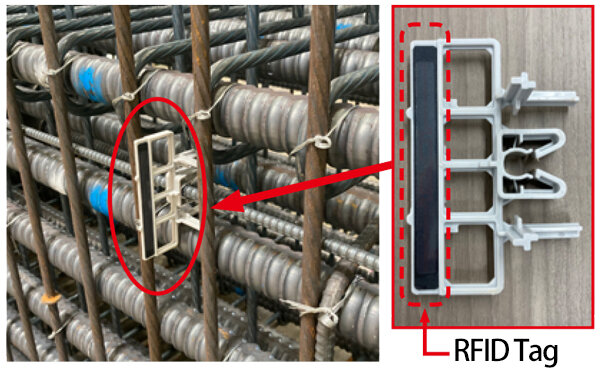
RFID Tag Integrated Spacer
Spacers with integrated RFID tags are embedded in PCa products to enable reading of unique number information. The tag is tuned to the UHF band and can communicate up to a distance of approximately 2 meters. The spacer is also uniquely shaped to maintain sensitivity. The introduction of this technology into next-generation PCa production management system PATRAC® will enable centralized production control from the factory to the project site, contributing to instant information sharing, prevention of misdelivery, and labor-saving management.
